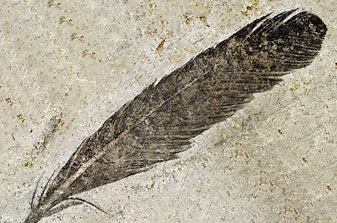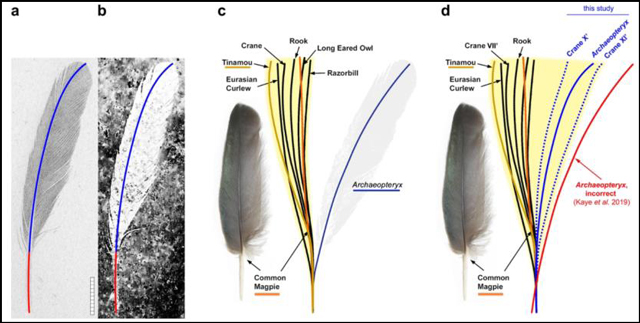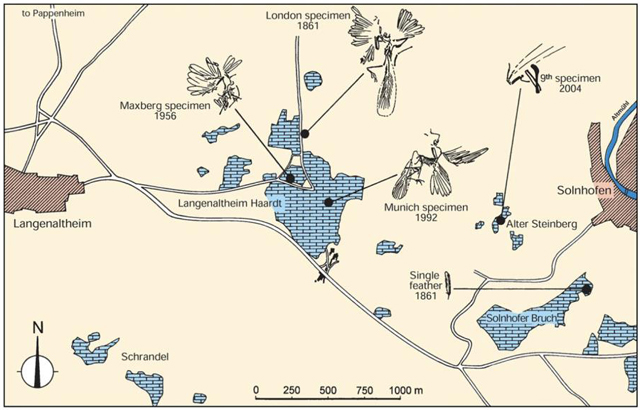Famous Feather Fossil – Probably Represents a Feather from Archaeopteryx
The feathers are flying when it comes to an iconic fossil, arguably one of the most significant in any vertebrate palaeontology collection – a single, carbonised feather from the Solnhofen area of southern Germany.
Described in 1861, this isolated feather specimen is regarded as the first fossil feather known to science. Having been scientifically studied just two years after the publication of Charles Darwin’s “Origin of Species”, the “Urfeder” – first feather in German, a modern-looking bird feather preserved in lagoonal sediments laid down around 150 million years ago, sent shock waves around the scientific community when it was first described.
The Iconic Feather Fossil – Is this from the “Urvogel” (Archaeopteryx lithographica)?

The Application of Laser-Stimulated Fluorescence
Ever since its discovery, scientists have debated what sort of creature this single feather came from. In February 2019, Everything Dinosaur reported on research conducted by a team of international scientists that applied a sophisticated imaging method called Laser-Stimulated Fluorescence (LSF) to reveal previously unseen details in a forensic examination of both the slab and the counter slab of the fossil feather. The team, which included Dr Michael Pittman (University of Hong Kong), proposed that the feather did not come from the famous “first bird”, but instead from an unknown species of dinosaur that co-existed with Archaeopteryx.
To read our blog post from February 2019, that disputed the claim that this specimen represented a feather from an Archaeopteryx: Iconic Feather Did Not Belong to Archaeopteryx.
New Study Re-affirms the Archaeopteryx Link
This new research utilised images generated from an electron microscope of the single feather specimen along with detailed examinations of known Archaeopteryx fossils that displayed feather impressions. The study published in “Scientific Reports” was led by Ryan Carney, an assistant professor of integrative biology at the University of South Florida. The researchers analysed nine characteristics of the feather, particularly the long quill, which runs up the centre of the specimen (centreline). This centreline is composed of two parts:
- Calamus – centreline below the skin (shown in red in the diagram below)
- Rachis – tubular extension of the calamus above the skin (shown in blue in the diagram below)
The New Study Suggests The Single Feather Fossil is Congruent with Archaeopteryx Feathers

Picture credit: Carney et al (Scientific Reports)
The photograph (above), shows (a) centrelines of the isolated fossil feather modified from Hermann von Meyer’s original 1861 description and (b) Laser-stimulated fluorescence image modified from the 2019 scientific paper. In (a) and (b), the centerline comprises the calamus (red) and rachis (blue). An alignment error made in the earlier (2019) research led to the orientation of the centreline of the fossil feather to be out of the expected range found in extant birds (c). The final figure (d) has been modified from (c) and shows a more representative range of centreline morphologies associated with modern birds (areas shaded yellow in (c) and (d).
A Feather from the Left Wing of Probably Archaeopteryx
Based on this new research, the scientists conclude that the single feather represents a feather from the left wing called a primary covert. Primary coverts are small contour feathers that overlay the main wing feathers. As similar feather characteristics were identified in other Archaeopteryx fossil feathers Carney et al conclude that the 1861 specimen probably does represent a feather lost by the famous “Urvogel” (Archaeopteryx lithographica).
Ryan Carney commented:
“There’s been debate for the past 159 years as to whether or not this feather belongs to the same species as the Archaeopteryx skeletons, as well as where on the body it came from and its original colour. Through scientific detective work that combined new techniques with old fossils and literature, we were able to finally solve these centuries-old mysteries.”
The Location of the Fossil Finds
In addition, the research team looked at the provenance of the single feather, where it was found in relation to known discoveries of Archaeopteryx remains. Four Archaeopteryx specimens, including the London specimen which is now the holotype for A. lithographica were found within 2.2 kilometres of the site where the single feather was discovered. All of these specimens are coeval (having the same age and origin), from the same horizon in the limestone, all linked by biostratigraphy. The Archaeopteryx material being associated with the same zonal ammonite fossils (Subplanites rueppellianus).
The Provenance of the Single Feather Fossil in Relation to Other Archaeopteryx Specimens

Picture credit: Carney et al (Scientific Reports)
Detecting and Interpreting Melanosomes on the Feather
The electron microscopy employed permitted the scientists to identify melanosomes (microscopic pigment structures). They determined that this primary covert feather was coloured matte black. Other studies have also shown the Archaeopteryx may have been black in colour, with some feathers showing iridescence.
The scientific paper: “Evidence corroborates identity of isolated fossil feather as a wing covert of Archaeopteryx” by Ryan M. Carney, Helmut Tischlinger and Matthew D. Shawkey published in Scientific Reports.
The Everything Dinosaur website: Everything Dinosaur.






Leave A Comment